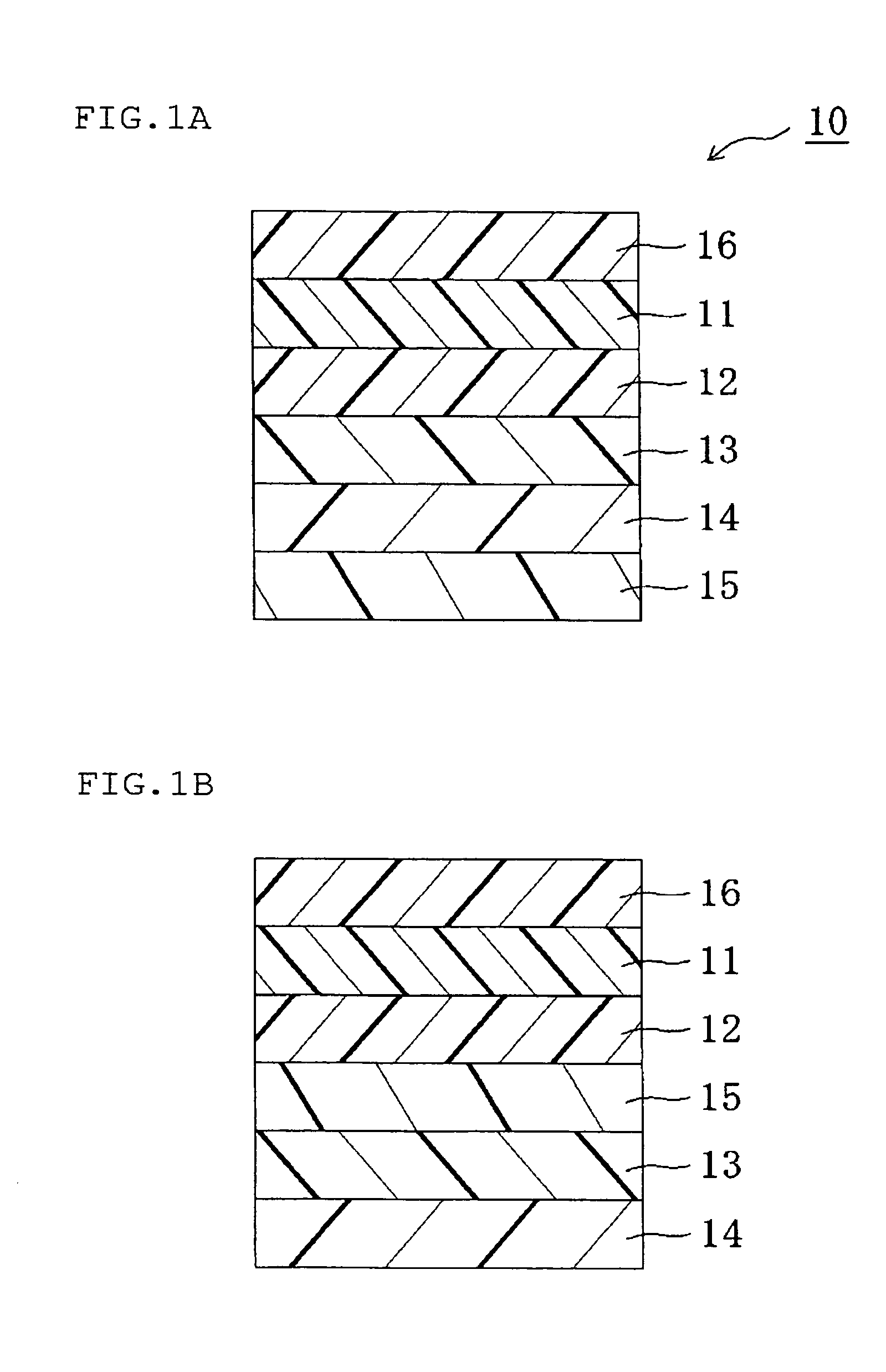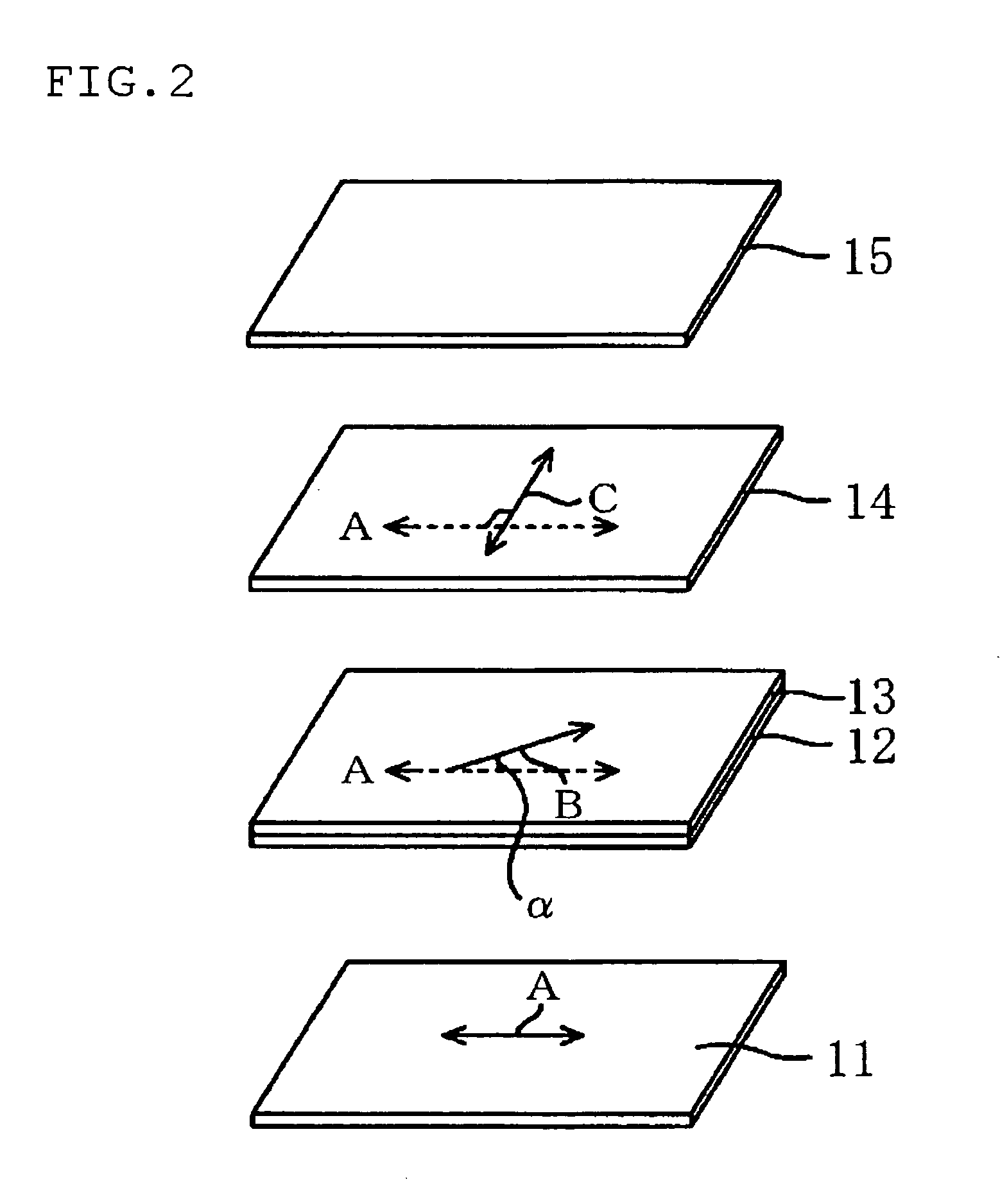Method of producing elliptically polarizing plate and image display using the elliptically polarizing plate
a technology of elliptically polarizing plates and image displays, applied in the direction of polarizing elements, instruments, optics, etc., can solve the problems of high cost and long time, film has problems in cost, and cannot exhibit the desired optical characteristics (such as the functions of /4 plates) over a wide wavelength range, so as to achieve no waste, high production efficiency, and low cost
- Summary
- Abstract
- Description
- Claims
- Application Information
AI Technical Summary
Benefits of technology
Problems solved by technology
Method used
Image
Examples
example 1
I. Preparation of Elliptically Polarizing Plate as Shown in FIG. 1A
I-a. Alignment Treatment for Substrate (Preparation of Alignment Substrate)
[0177]Substrates were subjected to alignment treatment, to thereby prepare alignment substrates.
[0178]Substrates (1) to (6): The surface of a polyethylene terephthalate (PET) film (thickness of 50 μm) was subjected to rubbing at a rubbing angle shown in Table 1 by using a rubbing cloth, to thereby form each of alignment substrates.
[0179]
TABLE 1SubstrateRubbing angle (angle α)(1)13°(2)−13°(3)23°(4)−23°(5)33°(6)−33°
I-b. Preparation of First Birefringent Layer
[0180]10 g of polymerizable liquid crystal (Paliocolor LC242, trade name; available from BASF Aktiengesellschaft) exhibiting a nematic liquid crystal phase, and 3 g of a photopolymerization initiator (IRGACURE 907, trade name; available from Ciba Specialty Chemicals) for the polymerizable liquid crystal compound were dissolved in 40 g of toluene, to thereby prepare a liquid crystal compositi...
example 2
II. Production of Elliptically Polarizing Plate as Shown in FIG. 1B
[0195]The same polarizer, protective layer, laminate of the first birefringent layer and the substrate, second birefringent layers (al) to (a7) and (b1) to (b2), the third birefringent layers (C1) to (C4) respectively formed on the substrate, and adhesive as those of Example 1 were used. The polarizer, the protective layer, the third birefringent layer, the first birefringent layer, and the second birefringent layer were used in the combination shown in Table 6, and were laminated by roll to roll, to thereby obtain each of elliptically polarizing plates B01 to B18. In the lamination step, the third birefringent layer was transferred from the substrate film to the surface of the protective layer, and the first birefringent layer was transferred from the substrate film to the surface of the third birefringent layer. The second birefringent layer was formed on the surface of the first birefringent layer.
[0196]
TABLE 6Pro...
example 3
[0197]The elliptically polarizing plates A01 were superimposed to measure a contrast ratio. Table 5 reveals that the elliptically polarizing plate had Rth3 / Rthp of 1.1. The elliptically polarizing plate had the minimum angle of 40° and maximum angle of 50° for contrast 10 in all directions, and a difference between the maximum and minimum angles of 10°. The minimum angle of 40° for contrast 10 in all directions was at a preferred level in practical use. Further, the difference between the maximum and minimum angles of 10° was small and was also at a very preferred level in practical use, and thus the elliptically polarizing plate had balanced visual characteristics.
PUM
| Property | Measurement | Unit |
|---|---|---|
| angle | aaaaa | aaaaa |
| angle | aaaaa | aaaaa |
| angle | aaaaa | aaaaa |
Abstract
Description
Claims
Application Information
 Login to View More
Login to View More - R&D
- Intellectual Property
- Life Sciences
- Materials
- Tech Scout
- Unparalleled Data Quality
- Higher Quality Content
- 60% Fewer Hallucinations
Browse by: Latest US Patents, China's latest patents, Technical Efficacy Thesaurus, Application Domain, Technology Topic, Popular Technical Reports.
© 2025 PatSnap. All rights reserved.Legal|Privacy policy|Modern Slavery Act Transparency Statement|Sitemap|About US| Contact US: help@patsnap.com



